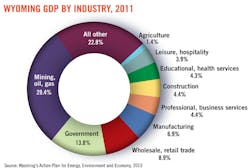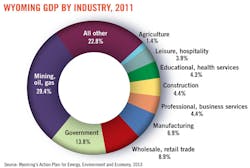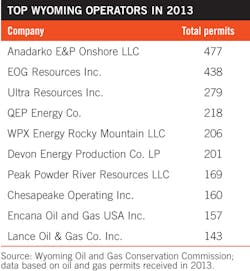Baseline water testing rule to remove ambiguity in Wyoming
Rachael Seeley, Editor
PAVILLION, Wyo.— Wyoming has adopted a rule that calls for operators to perform baseline testing of area groundwater before and after drilling.
The requirement, set to take effect on Mar. 1, stipulates that operators perform initial baseline water testing on water sources within a half-mile radius of a planned drillsite no more than 12 months before drilling begins. Follow-up water quality testing is then required once 12-18 months after production casing or liner has been set and again 36-48 months later.
John Robitaille, vice-president of the Petroleum Association of Wyoming, expects the groundwater testing will show that Wyoming's existing rules governing the completion and casing of wells sufficiently protect groundwater.
"I really believe that it will show that… everything we've been doing for years is very protective of groundwater," Robitaille told UOGR. Robitaille does not expect the new rule will be a problem for most producers and said many already have programs in place to monitor groundwater quality near their operations.
Along with field observations of the water such as odor, color, sediment, bubbles, and effervescence, operators will also be required to document a number of water characteristics including total dissolved solids, dissolved gases, presence of bacteria, total petroleum hydrocarbons, and presence of the BTEX compounds benzene, toluene, ethylbenzene, and xylenes.
If a free gas or a dissolved methane concentration of greater than 5 mg/l. is detected, a gas compositional analysis will be conducted to determine the gas type.
The rules enacted by the Wyoming Oil and Gas Conservation Commission would remove ambiguity about whether there is any relationship between drilling and groundwater contamination. The rules could also be useful in controversial cases like that in Pavillion, Wyo., where an absence of baseline water quality testing makes it difficult to conclusively establish or disprove whether drilling played a role in area water quality issues.
Jon Goldstein, senior policy manager at Environmental Defense Fund, said his organization is satisfied with the new regulations."We're very pleased with how the program turned out. We had extensive comments throughout the process and feel like the rule that the state has finalized is really one of the strongest rules in the country when it comes to doing this kind of baseline testing around oil and gas development," Goldstein told UOGR.
Federal land
Many Wyoming operators are already required to perform some type of groundwater monitoring for federal land.
Roughly 50% of Wyoming's land and almost three quarters of the state's minerals are owned by the federal government, said Jerimiah Rieman, policy advisor to Wyoming Gov. Matt Mead (R).
Producers drilling on federal lands will be required to meet groundwater quality monitoring standards set forth by both the federal Bureau of Land Management (BLM) and the state.
Rieman said operators working on federal lands are already required to apply for permits to drill with both BLM and Wyoming. For some operators, this means the new state standards must be met in addition to more comprehensive BLM water monitoring requirements at large projects in environmentally sensitive areas.
One such project is operated by Shell Exploration & Production Co. in the Upper Green River basin area, north of Pinedale field, on land primarily owned by the federal government.
Rieman said BLM requires Shell to adhere to not only a number of baseline elements but also ongoing groundwater monitoring requirements in the Pinedale area. The federal agency also mandated the company perform a comprehensive, multiyear environmental impact study before drilling began.
"They have been collecting that data for years. They certainly have significantly more data than we would require them to collect under our rule," Rieman told UOGR.
But this is not the case for every operator in every part of the state. Wyoming's new rules, Rieman said, will now require all operators to perform some level of groundwater testing before and after drilling.
Testing cost
Wyoming is home to a handful of unconventional plays, including portions of the Niobrara shale, the kerogen-rich Green River oil shale which is not being commercially developed, and the Powder River basin. Coalbed methane seams in the Powder River basin account for about one fifth of the state's natural gas production.
Estimates by Gov. Mead's office found that the new groundwater testing requirements will cost operators $2,000-6,000 for each of the three required sampling stages for a new drillsite. For multiwell pads, Rieman said, operators will only be required to perform testing for the first well drilled and cased.
A cost analysis performed by the Petroleum Association of Wyoming fell within the range identified by the governor's office. "Their estimate was $5,800 for the initial round of sampling, then $4,814 for each subsequent round, for a total cost of $15,458," Rieman said.
Pavillion case
The need for baseline water testing requirements has been underscored by the controversy in Pavillion. The small town garnered national media attention after the federal Environmental Protection Agency released a draft report that appeared to link groundwater contamination with the drilling of nearby gas wells.
The preliminary report, released in late 2011, suggested that water samples taken near gas wells operated by Encana Oil & Gas (USA) Inc. failed to meet safe drinking water standards and contained chemicals consistent with hydraulic fracturing.
EPA dropped its investigation last summer after the US Geological Survey performed a separate analysis that produced inconsistent results—raising questions about how EPA constructed monitoring wells and tested water samples. Encana said contaminants found in Pavillion water wells occur naturally, and the two test wells EPA drilled in 2010 were improperly constructed.
Policy advisor Rieman said that, although the Pavillion case was not the impetus for the new groundwater monitoring rule, it was not far from the minds of policy-makers as the rule was being drafted.
"Certainly Pavillion was in the back of our mind because we don't have baseline information that might help us to solve some of the issues that we see there," Rieman told UOGR. "We thought better to have that information to allow us to look back if we needed to."
The oil and gas industry is the largest revenue producer in Wyoming and accounted for nearly one third of the state's gross domestic product in 2011 (see figure). Wyoming ranks as the third-largest gas producing state in the US and the eighth-largest oil producer.
Eric K. Nelson, environmental and natural resources attorney with Lewis Roca Rothgerber, said the rule shows Wyoming is taking the lead in the regulation of hydraulic fracturing.
"The newest rule, in conjunction with the previously adopted rule requiring disclosure of fracing fluid ingredients, goes a long way towards establishing the baseline information necessary to track the effects, if any, of fracing on groundwater," Nelson said.


